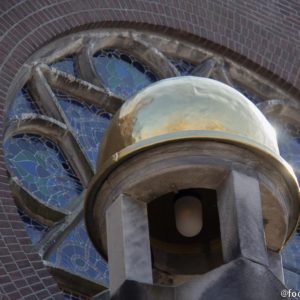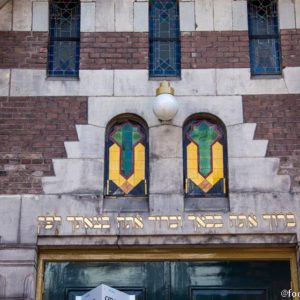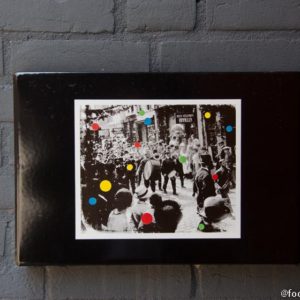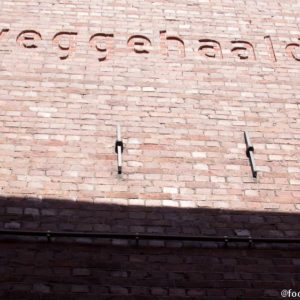Before World War II, the city center of Groningen had a thriving Jewish community. The heart of this community was the Folkingestraat.
In the folkingestraat, many remembrances of the Jewish district remain, and art pieces have also been added. These are often overlooked, however, since the history of the street is not well known.
We have translated pieces of an article (published originally in Dutch at http://www.focusgroningen.nl/groningen-centrum-de-joodse-folkingestraat/) for our readers as a guide to the “Nicest shopping street in the Netherlands 2014”.
Start: Folkingestraat 67 (across from the International Welcome Center North).
This is where you enter the former Jewish district. This neighborhood emerged in the years after the first synagogue was built in 1756, it was bordered by the Fish Market, the Zuiderdiep, the Herestraat and Munnekeholm.
The Jewish life in this neighbourhood, which ended abruptly in 1943 with the deportations, is commemorated through five works of art. The first one is the bronze door. The door handle is missing: a symbol representing the historical end of the Jewish district in Groningen.
This is also the starting point of the second piece of art: Galgal Hamazalot. In the middle of the street bronze moons starting as a crescent and developing into a full moon declining to a crescent again, symbolize the rise and fall of the Jewish community. It also refers to the Jewish calendar which is based on the phases of the moon.
The Synagogue (Folkingestraat 60)
The many horseshoe or keyhole symbols on the building show the Moorish style from 1906.
The two spheres on either side of the large terrace have been coated with gold leaf in 2011. The text in Hebrew above the entrance says: “You are blessed when entering and when leaving.”
Folkingestraat 16
Further down the road there used to be a kosher butcher named Isaac Nieweg. His name is on the tiled tableau. If you go inside the shop, meat hooks, where the butcher used to hang the meat, are still visible in the ceiling. The neighbor butcher Mozes Nijveen greeted Nieweg cordially everyday with the question: “Have you not left yet?” (In Dutch, “Zo, ben je nog steeds nie weg?”) The Nieweg family survived the war by fleeing to the United States in 1940.
Folkingestraat 12
In the entranceway of the building, an untitled work of art with an old photograph is visible. This picture symbolises the integration of the Jewish community into the Groningen society. The festive character of the picture is in sharp contrast with the next work of art.
Folkingestraat 11 & 9
In the alley between these two buildings is an artwork engraved high on the right-hand building, saying “weggehaald”, meaning removed. This refers, of course, to the deportations during World War II. The Jews during this time were literally removed from their houses, just as these letters were dug out of the wall.
So the next time you stroll through the “Leukste winkelstraat van Nederland 2014”, keep an eye out for these remembrances and consider the history of this former Jewish district.
 +31 (0)50 367 71 97
+31 (0)50 367 71 97  info@connect-int.org
info@connect-int.org




